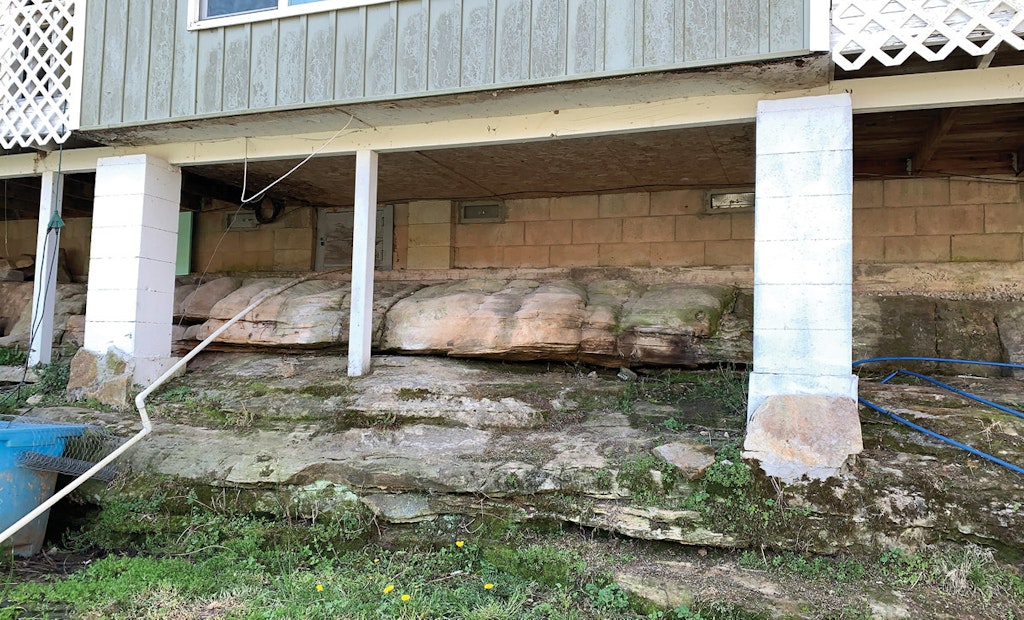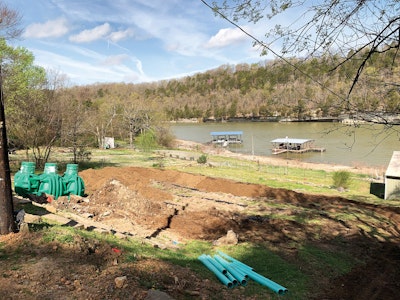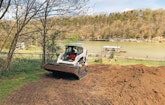
Bedrock was one of the challenges faced by the BBB crew when installing a new onsite system on the shore of Beaver Lake in northwestern Arkansas. The house foundation was poured on rock. (Photos courtesy BBB Septic)
Interested in Systems/ATUs?
Get Systems/ATUs articles, news and videos right in your inbox! Sign up now.
Systems/ATUs + Get AlertsTenants were interested in buying the house they had rented on Beaver Lake in northwestern Arkansas, and the owner agreed to install a new onsite system before the purchase was completed. But there were two big challenges: a setback zone on top of the ground, and rock under it.
This house was built in 1969, says Will Jones, who runs WK Wastewater Systems and designed the onsite solution for this home. Beaver Lake, created by a dam on the White River, was completed in 1966 and is under the oversight of the U.S. Army Corps of Engineers. It is the source of drinking water for about 450,000 customers in Fayetteville, Rogers and other cities clustered in the northwestern corner of Arkansas.
The lot was small, only 100 feet wide and about half an acre in area, Jones says. Permission of the Army Corps was required to site the drainfield system because it was within a setback zone, Jones says. The corps allowed it based on the type of system planned, he says, but the corps would not agree to the use of a chlorinator for secondary treatment. They required UV citing reliability and low maintenance, he adds.
System
Wastewater leaves the house in a 4-inch Schedule 40 PVC pipe and travels about 20 feet to the inlet of a Norweco Singulair Green unit. Effluent then flows a foot or so to the Norweco UV system. From there, water flows to a four-outlet Polylok dipper box that gives the drainfield 1.5 gallons in each dose of wastewater.
Dispersal is done with 4-inch pipe in four 60-foot-long laterals inside Infiltrator Quick4 Equalizer 24 low-profile chambers.
Flow through the system is by gravity, which kept the cost down, Jones says.
To do the job, installers from BBB Septic in Bentonville, Arkansas, used a Bobcat E50 and a Bobcat T190 tracked skid-steer.
Looking for a design
Jones made his initial site inspection visit with his two sons, Harlie, 15, and Porter, 13, who help out with his business. (He’s the county assessor, and onsite design is a side business.)
“We had just bought a little excavator [John Deere 26G] in October, and my son Harlie was running it. In the first or second dig, he dug up the waterline that went to their shop. They’re like, ‘Oh, we forgot about that.’”
“Before we dig, we always ask if there’s any utilities in the area. In this case the homeowner said she knew were everything was,” he says. In any case, he adds, the line had been privately installed and would not appear on utility maps.
When Jones looked at the soil near the house, it looked odd. “I said, I’m pretty sure this is fill, because it was so soft and so fluffy,” he recalls. Turns out it was fill. The area around the house had been built up because the grade is so steep, Jones says. Arkansas forbids installers from putting systems into fill, he says, but because this was a repair and not a new installation, the health department was flexible about a solution.
His goal was to put the drainfield system in the natural soil beyond the house pad. Laterals came within about 15 feet of what is called the “1135 mark.” It’s a line around the lake at 1,135 feet above sea level, and it defines the expected lake height for one flood in every 100 floods. Onsite systems are prohibited in the setback zone that extends 100 feet from the 1135 mark, and this is why the Army Corps approval was necessary.
Piper Satterfield, the septic design specialist at BBB, helped with the project because she has more knowledge of this equipment, Jones says.
The project required a good deal of time, he says, and any project along the lake does because of the need to satisfy local and federal regulations.
Rock of ages
Bedrock was the other big issue for the installation. It is a common problem in this area, says Brook Cannedy, installer on the project for BBB Septic. In some places, bedrock pokes through the ground, and in other places it lies not too far beneath the soil.
This home’s foundation was poured on top of bedrock, he says. The BBB crew (Cannedy, Paul Kirkhuff and Jeremy Satterfield) knew going in they would need to break rock to create a hole for the Singulair tank. So they took a jackhammer attachment for their mini-excavator. Usually, rock can be removed with only a backhoe bucket, Cannedy says.
“This was solid rock. It wasn’t fractured or anything,” he says. “It was eight hours of jackhammer time.” The crew removed close to 3 yards of the stuff.
Other than that, the job went smoothly, Cannedy says. “There was some delay in letting Arkansas weather stop raining for a few weeks to dry out.” Once that was past, installation took the planned five days.
Because of the shallow bedrock, trenches for the Infiltrator chambers were dug 4 inches deep. That left 4 inches of chamber above the soil, Cannedy says. So the crew brought in 19 truckloads of unscreened soil with a low clay content, a total of about 530 yards, to cover the chambers.
With the new system in place, the home’s occupants know they won’t endanger the lake every time they turn on a tap.









